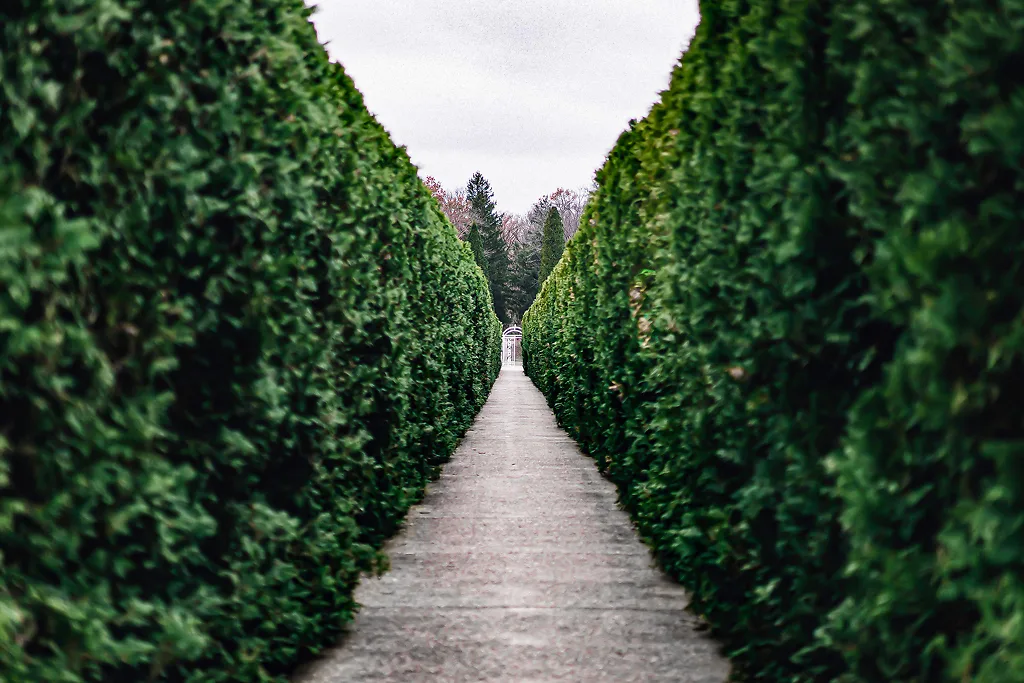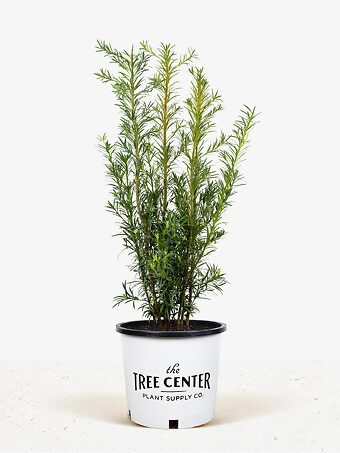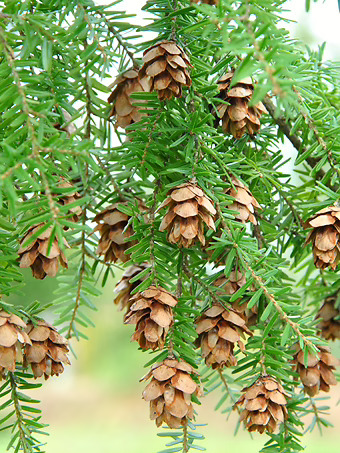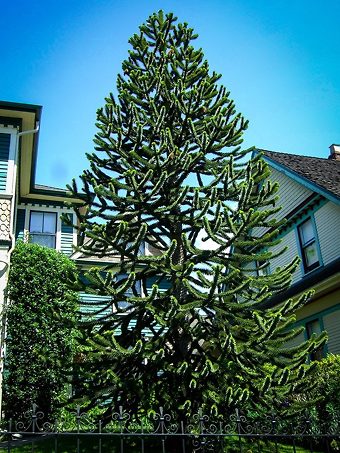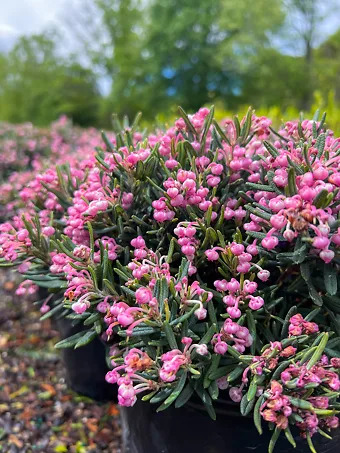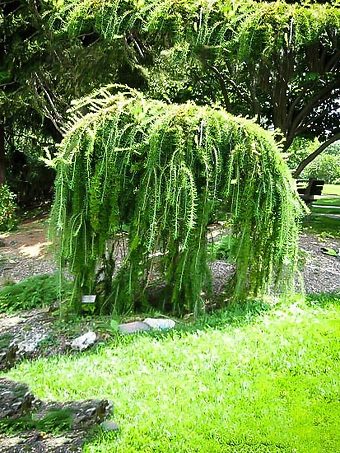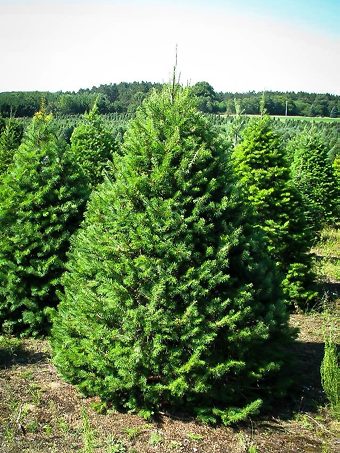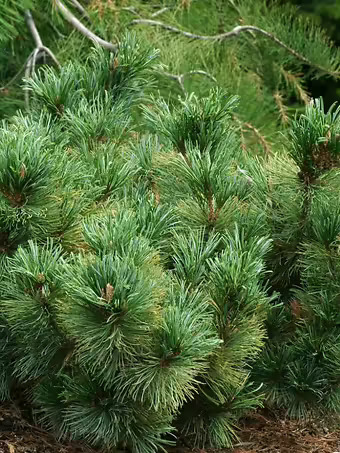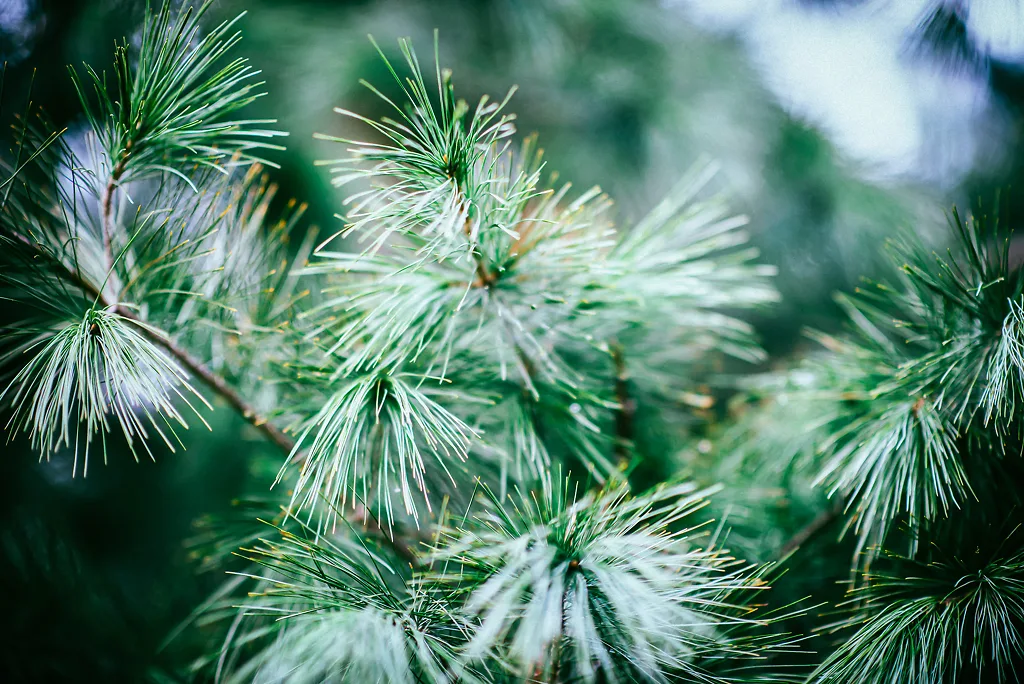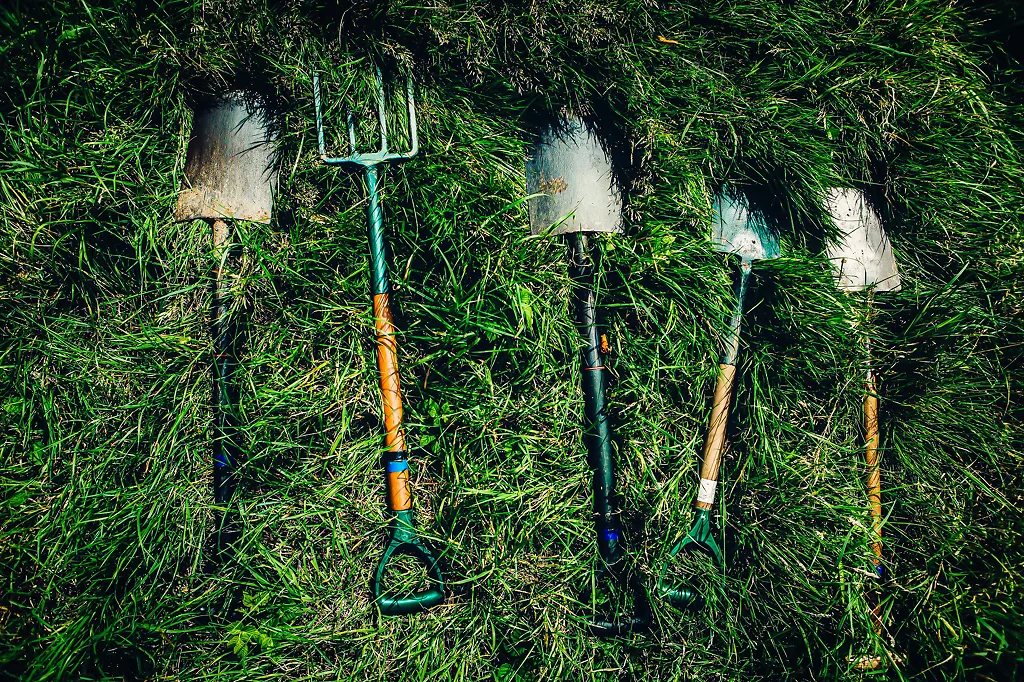Other Evergreen Trees
There are two main groups of evergreens – needle trees, correctly called conifers, and broad-leaf evergreens, which are a diverse group of plants differing from other flowering trees and shrubs only because they do not lose their leaves in winter. In addition, although really just enormous grasses, Bamboo Plants are also included among evergreens.
In the conifers, there are several large and well-known groups, such as fir, spruce, pine, cedar, cypress and arborvitae. In addition, though, there are several smaller groups, which do not give gardeners a wide range of plants, but which often include interesting, useful and decorative plants that enrich our gardens. These trees may sometimes be less well-known, but they make attractive specimens in a diverse variety of climatic and soil conditions. Their evergreen foliage brings us the same useful features of all-year-round protection and decoration for the garden as their more well-known cousins. They can often be clipped into hedges, allowed to grow naturally into privacy screens and barriers, or planted as individual specimens, for example as a tree in a lawn that can be decorated for the Holiday Season.
Among the broad-leaf evergreens, many are included in our shrub and hedges section, especially those grown mostly for flowering or training as hedges, but some don’t fit very well into that section, so we have included some unusual and interesting ones in this part of our site. Again, they are often single individuals, not members of larger groups.
So we have here, as ‘other’ Evergreen Trees, some very interesting and attractive plants, that are here because they don’t belong in the larger evergreen sections you will have already seen. In exploring this section, you will find a wide range of unique plants, that are available to bring interest and variety to your garden spaces. Rather than planting something ordinary, the best way to make a unique and interesting garden is to choose something a little different. Sometimes new gardeners are afraid of unusual plants, as they assume they are hard to grow. Here at the Tree Center we want to make life easy, not harder. So even among our more unusual plants we have plenty of easy to grow trees that will brighten your garden, and bring interest at many seasons, without putting you to work, or causing you problems.
The Best Features of Evergreen Trees
- Provide screening and foliage all year round
- Useful as specimens, or hedges and screens
- Often easily grown and trouble-free
- Long-lived and attractive garden plants
- Can be grown in many locations and climates
Growing Evergreens in Your Garden
Evergreens can be found that will grow in almost any garden, no matter where it is, whatever the soil, and how much water is available. In the coldest areas, choose Larch Trees, Canadian Hemlock, Douglas Fir or a Yew Tree. In warmer places, choose a Plum Yew, or a Monkey Puzzle Tree for something very different.
For shady places, Yew and Plum Yew are great choices, while in sun, Douglas Fir or the Monkey Puzzle Tree will thrive.
All these trees can be trimmed, but some trim better than others. Both Hemlock and Yew make beautiful hedges, and they can be trimmed into perfect formal shapes. Yew is almost unique among evergreens in several ways, but one practical way is that it can be cut very hard. Almost all evergreens can only be trimmed back to parts that still have needles on them – bare wood will not re-sprout. However even thick bare branches of Yew will sprout quickly, and a large plant can be cut back to any size. It will soon fill out again, growing densely into a beautiful new form. So if you neglect to trim for several years, or suddenly find your yew has outgrown its space, don’t worry, just cut it back as needed, and it will respond well.
Like all plants, evergreen trees benefit from good soil preparation when planting. Adding organic material to any soil is always a good idea, as it improves sandy soils be holding water, and clay soils by improving drainage. If you dig the soil deeply, you will be rewarded by the quickest possible growth and rapid establishment of your new trees. Always water once a week at least during the first year, during the warmer months. After that some evergreen trees are very hardy and drought resistant, while others do need a steady supply of water to do their best for you.
Some Coniferous Evergreens
| Common Name |
Botanical Name |
Hardiness Zones |
Mature Height |
Growth Rate |
Best Features: |
| Monkey Puzzle Tree |
Araucaria araucana |
7–10 |
30–80 ft. |
1–2 ft. per year |
Unique specimen tree with edible nuts |
| Larch Tree |
Larix decidua |
2–7 |
40–60 ft. |
1–2 ft. per year |
The Weeping Form is beautiful specimen in the garden |
| Yew Tree |
Taxus baccata |
4–7 |
30–80 ft. |
6 to 12 inches per year |
Hick’s Yew is a great garden form of this shade tolerant tree |
| Plum Yew |
Cephalotaxus harringtonii |
6–9 |
30–80 ft. |
6 to 12 inches per year |
Great ‘yew’ for hotter areas. The form Korean Gold is very colorful |
| Canadian Hemlock |
Tsuga canadensis |
3–8 |
30–100 ft. |
1–2 ft. per year |
Beautiful shade-tolerant tree that grows well in damper soil |
| Douglas Fir |
Pseudotsuga menziesii |
4–7 |
40–70 ft. |
1–2 ft. per year |
Need a disease-resistant improved form of Cypress |
With so many plants growing on the surface of our planet, it is inevitable that some are not part of larger groups, but occupy niche spots in the classification we use to describe plants. They are for that reason alone, special, but they also have some unique features that are definitely worth considering if you are looking for evergreens for your garden. So let’s take a brief look at some of the plants you will encounter, when you start exploring this part of our catalogue.
Monkey Puzzle Tree
When this tree was first introduced, its spiny leaves made one person suggest that climbing it would be a puzzle for a monkey, and the name stuck. Known to botanists as Araucaria araucana, this remarkable tree grows in the Andes Mountains of South America, chiefly in Chile and Argentina. There it forms dense evergreen forests, but in North America it is more likely to be found as a tall tree around older homes, because it was very popular back in the 19th century. This tree grows 50 feet tall, or more in time, with a strong central trunk and radiating branches all around. The upper part is rounded in a very distinctive way. The spread of this tree can be 20 feet or more, and young trees have branches right to the ground, but eventually the lower branches will die, leaving a clean trunk. The branches look ‘armor-plated’, with broad green scales covering all the younger branches, each one ending in a point.
This is a substantial tree, for a beautiful specimen in a large lawn, or to fill a corner of your property. It would make a dramatic and powerful screen along a boundary line too. The Monkey Puzzle Tree grows well from zone 7 to 10, so it can be grown across a large part of the country. It is a fast-growing tree, adding 12 to 24 inches a year, once it has become established. It grows best in deep, richer soils, but it will grow well in any well-drained soil in a sunny spot. If you have some unused land, you might want to make an investment for the future; this tree produces large crops of valuable and nutritious nut, called piñones, but only after about 30 years of growth. The cones fall naturally, so they are easy to harvest, for yourself or as a marketable crop.
Larch Trees
Larch is an exception to the rule followed by other conifers, because it is that rare thing, a conifer that loses its needles in winter. So really it doesn’t belong here at all, but we wanted to keep all our conifers together in the same place!
Larch are beautiful trees, usually with a central trunk, or sometimes two or three main trunks, with horizontal branches and slightly weeping side branches, carrying soft needles. The needles turn a beautiful shade of yellow in fall, before dropping for the winter. There are 11 species in the group, all rather similar, found growing in Siberia, China and Japan, across the Himalayas into Europe, and from Alaska to the Atlantic in northern North America. All grow in cooler places, often at high altitudes, and usually in damper soils. These trees are extremely hardy, and make great choices in areas as cold as zone 2.
Usually they grow into taller trees, but there is a special form of the European Larch which is very different. This is a weeping form, with branches that cascade downwards in a beautiful stream of green. This tree, Weeping Larch, Larix decidua ‘Pendula’, is usually grown on a short stem, but it can also be trained upwards into a taller specimen. However you choose to grow it, this beautiful tree is sure to attract attention and become a wonderful feature in your garden.
Yew Trees
Yew is another small, distinctive group of conifers, that are known for their ability to grow in shade. This, and their dense growth when trimmed, makes them ideal for hedges in shadier parts of the garden, and this is how they are usually seen. However, left unclipped they do in time become imposing trees that can be as much as 60 feet tall. There are only seven species, all similar, and they have narrow, dark-green needles, usually arranged in a double row down either side of the stems. A distinctive feature of these trees is that they do not have cones, like other conifers, but instead a seed with a bright red fruity coating. The coating is sweet and soft, but the seed is very poisonous, as is the rest of the plant. A drug called Taxol produced by these trees has been developed as a very promising cancer treatment.
In the garden, the European yew, Taxus baccata, is more attractive but less hardy than the Japanese Yew, Taxus cuspidata. These have been crossed together to produce a cold-hardy hybrid called Taxus x media. This is widely grown in colder areas for specimens and hedges. The most popular variety is Hick’s Yew, which forms an upright plant reaching 20 feet eventually, if left unclipped. This is a great plant for dense hedges in partial and even full shade – a use for which this plant is uniquely suited.
Plum Yew
While Yew grows best in cooler areas, for the south the Plum Yew is a great choice for a shade-loving evergreen. This plant will thrive in hot and humid conditions, and it should be much more widely grown in hot states. It is not a true Yew, and it is called Cephalotaxus harringtonii. The variety Korean Gold is especially attractive. As its name suggests, it has golden leaves, especially in spring and early summer, and this plant really brightens a shady spot, growing into a dense bush that can be trimmed as needed into almost any form.
Hemlock Trees
A small group of conifers found in shady places across the northern hemisphere, Hemlock trees grow naturally underneath taller forest trees. This makes them ideal for growing in shady parts of your garden, and on top of that they are hardy, all the way to zone 3. They grow well in cooler parts of the country, enjoying abundant rainfall and surviving heavy snow falls and ice-storms well. They grow best in damper soil, and with some clipping they also make a beautiful hedge, with soft foliage. At first glance, they look a little like a delicate yew tree, but they have regular cones, just like other conifers. There are about 8 species, growing in Asia and North America. The most well-known and the one most often grown in gardens is the Canadian Hemlock, Tsuga canadensis, which is a beautiful tree, often clipped lightly into conical shapes. It can also be left to grow naturally into a graceful tree with slightly weeping branches.
Douglas Fir
A relative of hemlock is the Douglas Fir, Pseudotsuga menziesii. This bold tree makes a beautiful specimen, again in colder parts of the country, growing well in zones 4 to 7. It has strong, broad branches, with flattened needles, and it can be grown as a specimen, or as a magnificent shelter screen. Unlike hemlock it needs full sun and soil that is not too dry, although it is reasonably drought resistant once established. This easy to grow tree is a great choice if you want a tree in your garden to turn into a giant Christmas tree for the holidays. It naturally has the right conical shape, and branches that are easy to drape with lights.
Some Broad-leaf Evergreens
These evergreens are just like regular trees and bushes. They have ordinary leaves, not the narrow needles of conifers, and they have flowers and fruits too. Often the fruit is spectacular, as it is in the Pyracantha, with its vibrant orange-red berries all fall and well into the winter months. The wonderful thing about broad-leaf evergreens in the garden is that they are, of course, evergreen, so they always have leaves, giving year-round privacy and interest. So they can be used as interesting specimens, grown to cover ugly walls and fences, and be trimmed into dense hedges too. Some, like the Pyracantha, have sharp thorns that make them ideal for security, keeping all kinds of intruders out of your garden.
Pyracantha
These plants are often called Firethorn, because they have bright orange to red berries in fall and winter, that can cover the plant almost completely. The foliage lasts all year, and these small trees grow well in warmer zones, from 6 to 9. The small, glossy leaves make this plant always attractive, and in spring it is smothered with clusters of white, sweetly-scented flowers. From these the berries develop. There are varieties with red, orange or yellow berries, and these are edible, making jams or preserves. The ‘fire’ part of the name refers to the color of the berries, and the ‘thorn’ part suggests that this plant has sharp thorns, which it does. These are not immediately visible, but a Firethorn growing beneath a window, or along the boundary of your property, is an impenetrable barrier to intruders, both four-legged and two-legged as well.
Firethorn can sometimes be subject to disease, so it always best to grow a disease-resistant hybrid form, so you avoid any problems. A great choice is the Mohave Pyracantha, a vigorous hybrid that grows strongly and quickly into a shrub up to 15 feet tall. It has bright orange-red berries and makes a stunning display. Pyracantha are often grown on walls, where they are a great way to turn a blank wall into an attractive feature. The long branches can easily be spread out and tied to the wall, and with some light trimming the plant soon becomes dense and turns into a solid wall of green and orange.
